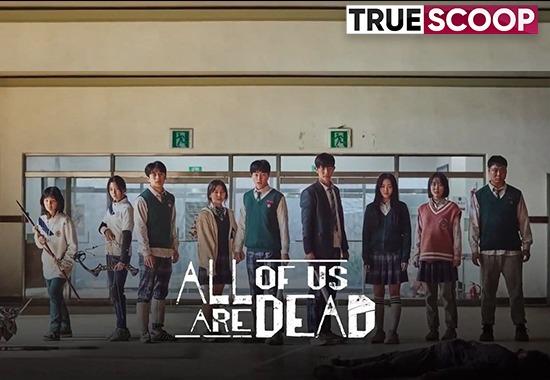I almost didn’t watch this phenomenal series, primarily due to its grim title, which whispers inexorable despair rather than screaming the blood-curdling terror that the zombie apocalypse genre is supposed to evoke. But just as judging a book by its cover is inadvisable, taking a tv series’ name at face-value can be equally deceptive.
‘Squid Games’ brought K-Drama to the global entertainment stage in a grand style, starting a revolution of sorts, turning almost every media dimension into a game with a squid in it. A.U.A.D.has now built a sumptuous palace for the Korean Drama to stay and rule entertainment spaces everywhere.
How has it managed to do so, when there is nothing novel about zombies or apocalypse? In fact, the two can be considered some of the most hackneyed elements of the entertainment industry in the last five decades or so. Combine this with the weariness for death and disease that the pandemic has caused in populations everywhere.
The primary reason for its spectacular success lies in A.U.A.D.’s incredibly nuanced and multi-layered storytelling. The show is set in a high school of a South Korean city. The said school becomes the birth-place of an extremely dangerous bug (the virus-causing COVID would be considered a beneficent saint in comparison). This zombie-making virus is the result of a failed experiment by one of the science teachers employed at the school. What’s new in this? Happens all the time, right?
The newness comes from the motive behind the bungled-up experiment. It’s not mad ambition, but love – a hapless father’s measureless love for his weak, bullied, broken-spirited son, who is also a student at Hyosan High School. The father, who holds a Ph.D. in genetics from an Ivy League university, amps up his son’s adrenaline-pumping mechanism to enable him to fight back against the bullies who harass and abuse him relentlessly. The absolutely meek person becomes uncontrollably aggressive. In fact, the virus strips its host(s) of every feeling, emotion, and ability, leaving behind nonstop and irreversible aggression.
The greatest premise in the world can fall flat without artistic execution, and the action sequences –panic-driven struggles, infliction of ghastly wounds, and the scary way in which an infection can spread over wide areas in a matter of minutes –in A.U.A.D. are nothing if they are not artistically realistic. The series fully engages one’s attention from the very first gory sequence, when one hasn’t even come to know the main characters yet.
Like with every other work, it is these characters that are the soul of the show. The makers make you invested in the welfare of each of these effortlessly and quickly, so that your heart lurches every time one of them gets in the way of danger, which obviously happens all the time!
The Korean names can be hard to grasp and keep track of for Indian viewers at first, but this difficultly vanishes by the middle of the third episode, at the latest.There are essentially two male and two female leads, along with their respective friends and foes.
There’s Lee Cheong, the fearless, selfless, and good-looking son of a restaurant owner. When all hell breaks loose, Lee Cheong proves to be exceptionally resourceful and heroic. He is also secretly in love with his childhood friend and classmate, Nam On-jo. On-jo’s father is a firefighter, who has taught his daughter a lot about survival techniques of various kinds.
Lee Cheong’s world – which is already ripping apart at the seams due to the sudden zombie outbreak – goes further topsy-turvy when he learns that On-jo (whom he loves) is smitten with Bare-su, a handsome boy with pro-level fighting skills.
Bare-su is Lee Cheong’s friend and a recently reformed bully, who mixed with the bad elements of the school until the previous session. Unknown to everyone, Bare-su secretly admires Nam-Ra, thealoof top student and class president.
All stories need their villains, and if they can be super-villains, the cutting-edge of the tale grows all the sharper.Yoon Gwi-Nam, A.U.A.D.’s utterly slimy, sadistic, and despicable protagonist, adds a dimension of terror to the all-too-prevalent horror unfolding at Hyosan High.
While all this makes for top-notch, binge-worthy entertainment, the magical factor that makes this series unique and extraordinarily popular across nations and diverse audiences is the masterly depiction of the immutable nature of the good and the evil elements innate to some human beings. Much as some apparently normal schoolboys turn into savages and murderers in William Golding’s immortal work, ‘The Lord of the Flies,’ some Hyosanstudents tap into hidden reservoirs of malignity after the zombie virus breakout. In a way, these physically-healthy students are way worse than the infected overrunning the school – the zombies, who can’t help doing what they do (mauling and biting).
Conversely, there are heart-rending moments when the students you have come to know and love over several hours of immersive watching are bitten. The short windows of time between being bitten and turning into raging monsters are rife with raw emotions pulling you, the viewer, deeper into the rapidly-disintegrating world of Hyosan High.
Another thing working in the show’s favour is the way it ends: with hope. It basically says that all of us are not dead! In conclusion, spending eight hours of one’s life in ravenously consuming episode-after-episode of Season 1 of ‘All of Us are Dead’ is a pretty good investment of one’s time.
